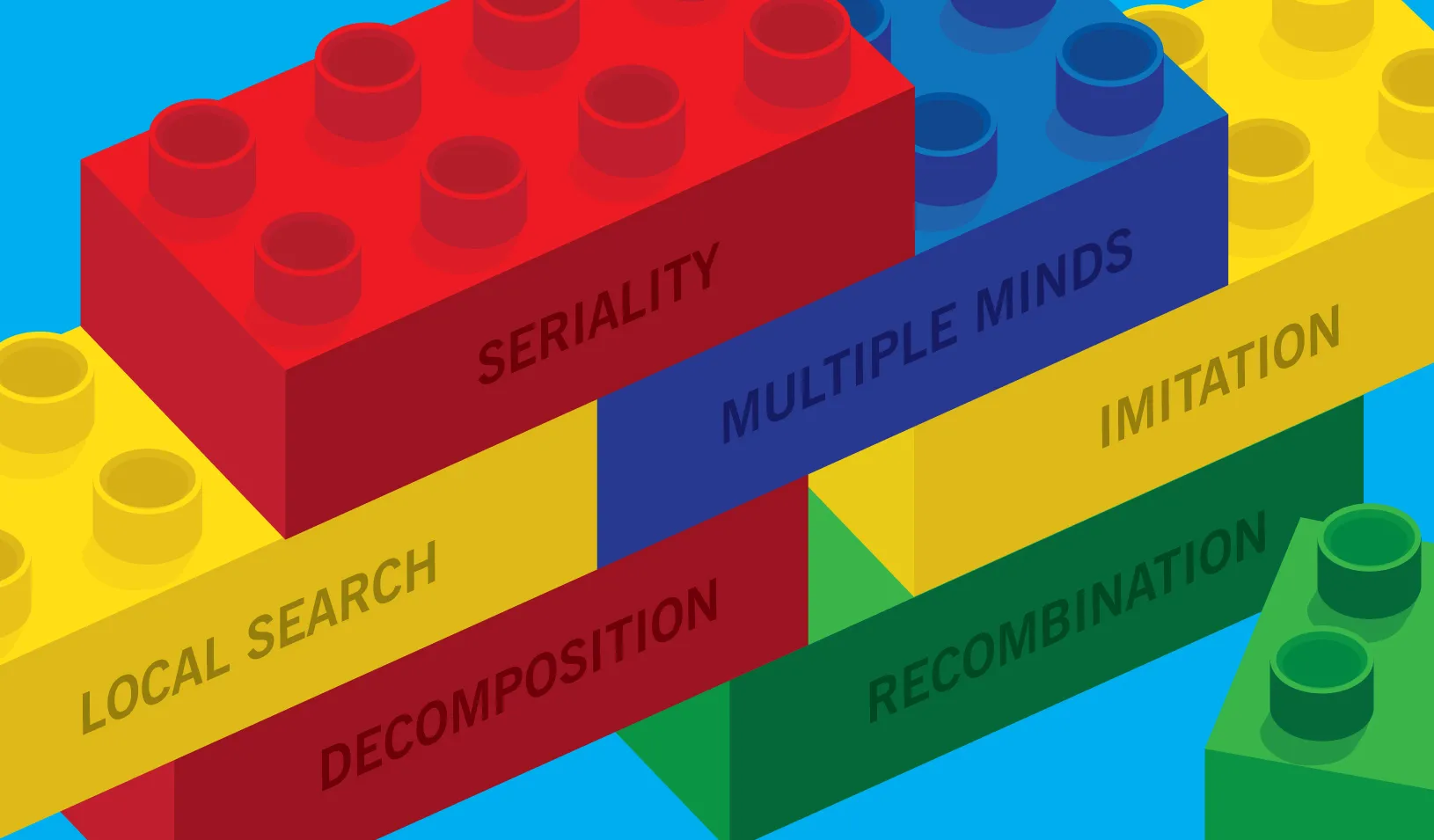Jonathan Bendor: A Toolkit for Solving Problems
Is classic research on decision-making still relevant today?
May 29, 2015

When solving problems, professor Jonathan Bendor recommends an approach that uses basic building blocks. | Illustration by Tricia Seibold
In the middle of the 20th century, the standard recommendation regarding problem solving went something like this: Create an extensive strategic plan with a few rigidly outlined logical steps. The synoptic method, as this conventional procedure was known, amounted to a prescription that didn’t actually work well for hard problems. Indeed, when faced with really complex decisions, organizational behavior theorist Charles Lindblom argued the problem solver was actually better off “muddling through.”
Problem-Solving is a Team Sport
How do you solve a complex problem using a toolbox of heuristics as Stanford GSB professor Jonathan Bendor suggests?
Bendor considers the hypothetical dilemma of patients missing their medical appointments. When people don’t show up, it wastes hospital resources and possibly jeopardizes their health.
The makeup of the team, which is setting out to solve the problem, is important. Bendor recommends including “multiple minds.”
For example, the initial team would likely include a health administrator, a statistician, a doctor, and maybe a nurse. Later, team members might add a patient and a front desk receptionist to provide “cognitive diversity,” or wide-ranging perspectives.
Using the “decomposition” concept, the team could break down the problem into more manageable pieces, while also using the idea of “imitation,” in which the team seeks to answer the question: How have other hospitals and clinics dealt with this issue?
In this case, the group breaks into subcommittees with each focusing on a different aspect of the problem. One could design a patient survey, another examines the efficacy of the appointment reminder notice, another tries to determine the causes of patient drop-off, and another researches what’s worked well for other hospital settings.
The subcommittees discover things along the way. Some are relatively easy fixes: The receptionist has been notifying patients 72 hours before the appointment, but it turns out a 24-hour notification leads to better turnout. Others are more challenging: The hospital serves low-income people who lack consistent childcare, transportation, and guaranteed time off work.
Through “recombination,” the problem solvers design a solution. They implement on-site childcare borrowing from the exercise club model: Parents can drop off their children without an appointment. And, they introduce an automated notification system that lets patients decide when and how they would like to be reminded of their appointments.
Lindblom’s crucial move in his 1959 essay “The Science of Muddling Through” and partner papers was to challenge the conventional prescription to problem solving. He introduced the idea of disjointed incrementalism, a package of heuristics that could be used to make small, incremental changes along the way.
Disjointed incrementalism rang true for several generations of scholars and problem solvers. Indeed, “Muddling Through” is one of the most cited articles in the field of organizational behavior. More than half a century later, Stanford GSB professor Jonathan Bendor revisits Lindblom’s classic work of applied theory to determine if it still informs the way people and organizations make decisions today.
What he found was mixed. In a new paper, Bendor, a professor of political economy, makes the case that disjointed incrementalism is “dead yet flourishing.” Although the overall theory of disjointed incrementalism is a “spent intellectual force,” its components, especially the “Big Three” — local search, iterative adaptation, and distributed intelligence — are flourishing.
Indeed, Bendor prefers a toolkit approach to decision-making in which incrementalism’s Big Three are vital heuristics — a rule of thumb that cuts a complex problem down to a manageable size.
They may not work as an integrated problem-solving technique, but as individual heuristics they work great. To clarify, Bendor recommends an approach that uses basic building blocks.
Consider Duplo blocks, the little sibling to Lego building blocks. Kids like Duplos because the pieces can be combined and recombined to build whatever the imagination desires. The same holds true for decision-making strategy, says Bendor.
When faced with a difficult decision, the problem solver, Bendor says, is better off turning to “a toolkit of heuristics that can be deployed separately and combined in various ways.”
Bendor’s research shows we actually have more options when it comes to solving hard problems than “Muddling Through” suggested. “There aren’t just two fixed methods of decision making like Lindblom thought,” Bendor says, referring to disjointed incrementalism and the synoptic method. “The elements can be broken down and then combined and recombined in new ways.”
According to Bendor, the best problem solvers mix and match the cognitive shortcuts to reach their solution. The idea is growing in cognitive psychology that experts in information-intensive domains, like teaching, chess, or medicine, become skilled because they garner enormous mental libraries of heuristics and patterns, he says.
When faced with a tough problem, Bendor recommends choosing among these methods.
Decomposition
Carve off part of a big problem and disperse its subcomponents to different groups. “You can have a problem that’s too big for anybody’s mind, but if you break off a piece of it, it’s more manageable,” Bendor says.
Local Search
Evaluating something that’s radically different from the status quo is bound to be fraught with error. Bendor recommends searching in the neighborhood of the status quo. It’s easier to design new alternatives if they are similar to those that already exist.
Seriality
Solutions for hard problems are rarely complete. Lindblom used the term “seriality” or iterative adaptation to talk about small changes made rapidly. “This plan will get us from A to G,” explains Bendor. “That’s pretty good. And then from G we’ll look around and think again and figure out how to get from G to R. Then when we’re there we’ll figure out [the rest].”
Multiple Minds
Having many people working independently on the same problem increases the likelihood of success, Bendor says, referring to what Lindblom calls distributed intelligence. It also helps to include people from varied backgrounds. For example, a team wrestling with a big data problem might consider incorporating a visual artist, cognitive scientist, and computer scientist to bring different insights to the problem solving.
Imitation
Find out how other organizations are already dealing with a problem and imitate those who are successful, says Bendor.
Recombination
Elements from different domains can be combined and tweaked to form something new. Or as Bendor says, “Subroutines from each approach can cross-breed and produce viable offspring.”
For media inquiries, visit the Newsroom.
Explore More

Jensen Huang on How to Use First-Principles Thinking to Drive Decisions

Why Investors Throw Money at Eccentric CEOs



